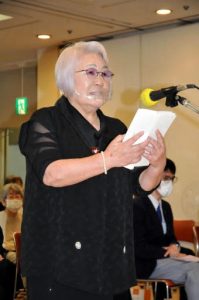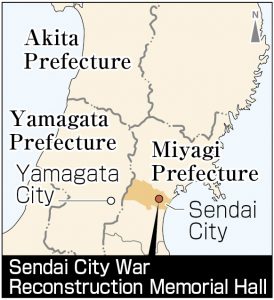Seventy-five years after the atomic bombing—Survivors’ groups at crossroads, Part 6: Continuation
Jul. 30, 2020
by Yo Kono, Staff Writer
On July 19, a memorial service for A-bomb victims was held at the Sendai City War Reconstruction Memorial Hall. Hisako Kimura, 83, a resident of Sendai City and president of an A-bomb survivors’ organization in Miyagi Prefecture, stood before a memorial pillar on which is inscribed “The spirit of A-bomb victims of Miyagi Prefecture.” Her eyes filled with tears. “It’s been 75 years since the unprecedented catastrophe. The horrific scenes never disappear from memory, even for a moment.” About 90 people listened intently to the explanation offered by Ms. Kimura, who experienced the atomic bombing in Hiroshima.
It was the 34th memorial service, held every summer since its beginning. Although the coronavirus pandemic was a concern, Ms. Kimura decided to hold the service with the idea, “I simply have to commemorate the A-bomb survivors who died during the past year.” Thorough preventive measures were adopted to protect against spread of the virus, such as the wearing of masks and disinfecting of seats. Despite that, however, the social gathering usually held after the service was canceled this year.
Chagrin of losing father in atomic bombing is starting point
With the aging of A-bomb survivors, the organization’s current membership numbers about 30 people, 20 percent of what it was 30 years ago. This year, only four survivors attended the service. Last September, a female survivor who supported the organization as treasurer died of lung cancer. Now, Ms. Kimura manages virtually everything by herself. She remains positive, however. “The chagrin of losing my father in the atomic bombing is my starting point. I’ll continue the service as long as I live.”
On that day, August 6, Ms. Kimura was exposed to the atomic bombing at a house owned by her grandfather in the Osuga district (now part of Higashi Ward), 1.6 kilometers from the hypocenter. She had no noticeable external injuries besides the cuts left on her face by shards of flying glass. Her father, a physician, was near their home in the Horikawa district (now part of Naka Ward), 700 meters from the hypocenter, heading to see a patient at the patient’s home. He was severely burned.
On the third night after the bombing, he said in his dying moments, “I am so mortified.”
The family moved to Tokyo when her brothers got into schools there. That is where Ms. Kimura learned about the A-bomb survivors’ movement. With her late father’s words etched in her mind, she naturally threw herself into the movement. After getting married, she started a new life in Sendai City about 40 years ago. She joined the A-bomb survivors’ organization in Miyagi Prefecture and served as its secretary-general for an extended period. In April last year, she became the organization’s president.
She also made appeals to people in the United States, the country that dropped the atomic bombs. She traveled to New York in 2005, 2010, and 2015, as a member of a delegation dispatched by the Japan Confederation of A- and H-Bomb Sufferers Organizations (Nihon Hidankyo), in conjunction with the Review Conference of the Parties to the Treaty on the Non-Proliferation of Nuclear Weapons (NPT). “Give back my father,” she shouted during one demonstration. She shared her A-bomb experience with students in the United States, calling for nuclear weapons to be eliminated.
Ms. Kimura is more than 80 years old and feels herself growing weaker. She has undergone seven operations for uterine cancer, cataracts, and other issues, and her knees were replaced with artificial joints. “It’s painful to stand for a long time,” she explained. A walking stick has become indispensable for her. However, she continues speaking about her A-bomb experience at schools in Miyagi Prefecture.
Ms. Kimura pins her hopes on members who are second-generation survivors, including her eldest son. Starting about five years ago, Masanori, 52, a company employee who lives with Ms. Kimura, has been helping set up a hall for memorial services and panel exhibits hosted by the organization. Since last year, a second-generation female member has presided over the memorial ceremony, taking over the reins from Ms. Kimura.
Masanori recognizes his responsibility as a second-generation survivor. “I’ve been helping her without really knowing the ropes, but I am aware that someday I’ll have to take over.” He was scheduled to join Nihon Hidankyo’s delegation this spring for the first time, but the NPT Review Conference was postponed due to the COVID-19 pandemic. He will decide whether or not to go to the United States when a new conference schedule is determined.
This year marks the 75th anniversary of the atomic bombings. On August 6, Ms. Kimura will attend the annual Hiroshima Peace Memorial Ceremony held at the Peace Memorial Park, in Naka Ward, Hiroshima, as a representative of family members of the victims. With the hope that “my son and other second-generation survivors will have more confidence in taking over my activities by observing what I do,” she plans to visit her father’s grave in the city’s Inari-machi, Minami Ward.
(Originally published on July 30, 2020)
Memorial service conducted with support of second-generation survivors
On July 19, a memorial service for A-bomb victims was held at the Sendai City War Reconstruction Memorial Hall. Hisako Kimura, 83, a resident of Sendai City and president of an A-bomb survivors’ organization in Miyagi Prefecture, stood before a memorial pillar on which is inscribed “The spirit of A-bomb victims of Miyagi Prefecture.” Her eyes filled with tears. “It’s been 75 years since the unprecedented catastrophe. The horrific scenes never disappear from memory, even for a moment.” About 90 people listened intently to the explanation offered by Ms. Kimura, who experienced the atomic bombing in Hiroshima.
It was the 34th memorial service, held every summer since its beginning. Although the coronavirus pandemic was a concern, Ms. Kimura decided to hold the service with the idea, “I simply have to commemorate the A-bomb survivors who died during the past year.” Thorough preventive measures were adopted to protect against spread of the virus, such as the wearing of masks and disinfecting of seats. Despite that, however, the social gathering usually held after the service was canceled this year.
Chagrin of losing father in atomic bombing is starting point
With the aging of A-bomb survivors, the organization’s current membership numbers about 30 people, 20 percent of what it was 30 years ago. This year, only four survivors attended the service. Last September, a female survivor who supported the organization as treasurer died of lung cancer. Now, Ms. Kimura manages virtually everything by herself. She remains positive, however. “The chagrin of losing my father in the atomic bombing is my starting point. I’ll continue the service as long as I live.”
On that day, August 6, Ms. Kimura was exposed to the atomic bombing at a house owned by her grandfather in the Osuga district (now part of Higashi Ward), 1.6 kilometers from the hypocenter. She had no noticeable external injuries besides the cuts left on her face by shards of flying glass. Her father, a physician, was near their home in the Horikawa district (now part of Naka Ward), 700 meters from the hypocenter, heading to see a patient at the patient’s home. He was severely burned.
On the third night after the bombing, he said in his dying moments, “I am so mortified.”
The family moved to Tokyo when her brothers got into schools there. That is where Ms. Kimura learned about the A-bomb survivors’ movement. With her late father’s words etched in her mind, she naturally threw herself into the movement. After getting married, she started a new life in Sendai City about 40 years ago. She joined the A-bomb survivors’ organization in Miyagi Prefecture and served as its secretary-general for an extended period. In April last year, she became the organization’s president.
She also made appeals to people in the United States, the country that dropped the atomic bombs. She traveled to New York in 2005, 2010, and 2015, as a member of a delegation dispatched by the Japan Confederation of A- and H-Bomb Sufferers Organizations (Nihon Hidankyo), in conjunction with the Review Conference of the Parties to the Treaty on the Non-Proliferation of Nuclear Weapons (NPT). “Give back my father,” she shouted during one demonstration. She shared her A-bomb experience with students in the United States, calling for nuclear weapons to be eliminated.
Ms. Kimura is more than 80 years old and feels herself growing weaker. She has undergone seven operations for uterine cancer, cataracts, and other issues, and her knees were replaced with artificial joints. “It’s painful to stand for a long time,” she explained. A walking stick has become indispensable for her. However, she continues speaking about her A-bomb experience at schools in Miyagi Prefecture.
Ms. Kimura pins her hopes on members who are second-generation survivors, including her eldest son. Starting about five years ago, Masanori, 52, a company employee who lives with Ms. Kimura, has been helping set up a hall for memorial services and panel exhibits hosted by the organization. Since last year, a second-generation female member has presided over the memorial ceremony, taking over the reins from Ms. Kimura.
Masanori recognizes his responsibility as a second-generation survivor. “I’ve been helping her without really knowing the ropes, but I am aware that someday I’ll have to take over.” He was scheduled to join Nihon Hidankyo’s delegation this spring for the first time, but the NPT Review Conference was postponed due to the COVID-19 pandemic. He will decide whether or not to go to the United States when a new conference schedule is determined.
This year marks the 75th anniversary of the atomic bombings. On August 6, Ms. Kimura will attend the annual Hiroshima Peace Memorial Ceremony held at the Peace Memorial Park, in Naka Ward, Hiroshima, as a representative of family members of the victims. With the hope that “my son and other second-generation survivors will have more confidence in taking over my activities by observing what I do,” she plans to visit her father’s grave in the city’s Inari-machi, Minami Ward.
(Originally published on July 30, 2020)









